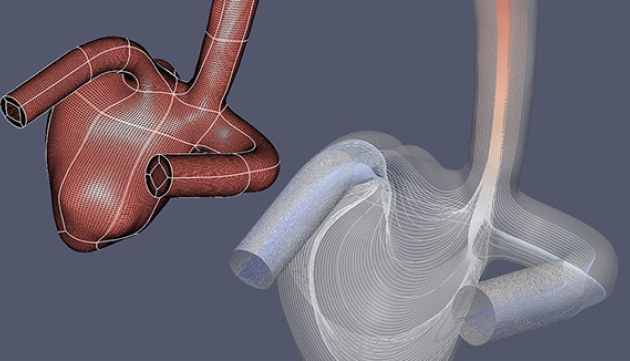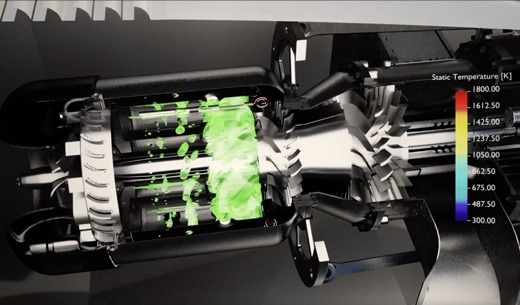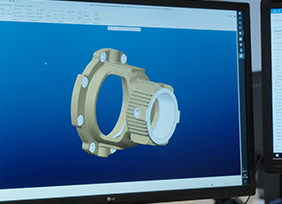Overview
Fidelity Flow for Turbomachinery
A complete end-to-end solution for turbomachinery design
Engineers looking to combine speed and accuracy for their virtual turbomachinery designs trust Cadence for their toughest challenges. The Cadence Fidelity Flow for Turbomachinery is a unique toolset that encompasses a complete end-to-end solution: 1D to 3D design, meshing, CFD, and optimization, all in one single environment. Thanks to more than 75 years of expertise in rotating machinery, the environment displays unsurpassed ease of use and accuracy. Components range from multi-stage axial to radial to mixed-flow configurations: compressors, turbines, pumps, fans, propellers, and contra-rotating propellers.

KEY BENEFITS
Maximize Your Machine’s Output Like Never Before
To reach maximum performance in turbomachinery design, diverse challenges must be tackled: unique power-saving principles, managing the connection of large flow systems, and daring to go faster than ever. Your solver will need to keep up with your creativity. Fidelity Flow for Turbomachinery is here to provide the exact environment you need to achieve your potential within all aspects of CFD for turbomachinery.
Preliminary and Detailed Design
Extend the power of Fidelity Flowwith integrated preliminary and detailed design tools of the Agile package, thanks to our partnership with Concepts NREC. The Agile package offers a unique toolset that encompasses a complete end-to-end solution: 1D to 3D, meshing, CFD, and optimization, within one Fidelity CFD workflow.
Structured and Unstructured Seamlessly Combined
Fidelity Automesh offers structured meshes with unsurpassed speed and accuracy. Combined with its unstructured meshing capabilities for peripherals, such as volutes, inlets, etc., complete applications can be solved using the most optimal approach for each part.
High-Speed Turnaround Time
Fidelity Flow for Turbomachinery is optimized by scaling linearly on thousands of CPU cores, as well as on GPU. Combined with our patented CPUBooster technology, a unique convergence acceleration technique, computation time is reduced even further.
Optimization and Uncertainty Quantification
To maximize performance and minimize performance variability, the Fidelity Optimization framework provides access to the Minamo optimization engineTake into account uncertainties and quantify the influence of variability on the simulation prediction to ensure your optimization is in real-life conditions.
Full-Engine 3D CFD Simulation
With the purpose to meet the future requirements of aircraft engines in terms of low emissions, high reliability and efficiency, a novel highly efficient fully coupled RANS-based approach has been developed, enabling the simulation of a full aero-engine within a single code.
One of the advantages of a fully coupled approach over a component-by-component approach, is that the boundary conditions at the interfaces do not need to be guessed. A Smart Interface methodology ensures a direct coupling between the different engine components, compressor- combustor-turbine, and allows the CFD models to vary between each component within the same CFD code.
For the simulation of the combustion process, the Flamelet Generated Manifold (FGM) method is applied. While the approach is superior to classical tabulated chemistry approaches and reliably captures finite-rate effects, it is also computationally inexpensive.
The non-linear harmonic (NLH) method is used to model the unsteady interaction between the blade rows as well as the influence of the non-homogeneities at the combustor outlet on the downstream turbine blade rows. This method is two to three orders of magnitude faster than a classical URANS simulation.
Customer Story
Kawasaki Heavy Industries Uses Fidelity to Speed Up their Design Cycle
“Cadence's turbomachinery CFD solutions are widely used by KHI to support the design and development of various products such as gas turbines, jet engine compressors, steam turbines for power generation,... Cadence software automatically generates high-quality structured and unstructured meshes and provides high-speed throughput flow computation thanks to Cadence's innovative technologies, such as the CPU booster and non-linear harmonics, enabling a significant reduction of the design cycle time and cost”.
Yusuke SAKAI, Senior Manager, Engine Technology Development Department
Aero Engine Business Division, Kawasaki Heavy Industries, Ltd.
Main Applications
Solve your toughest challenges with Fidelity Flow
Non-Linear Harmonic (NLH) Method
Gaining three orders of magnitude in solving speed for periodic unsteady simulation of rotating parts.
With the NLH method, users can solve transient behavior 100 times faster, capturing clocking, blade row interactions, tonal noise, inlet distortion, etc. This unique technique computes the unsteady flow field by means of the Fourier decomposition of the periodic fluctuations, based on a pre-selected number of harmonics, typically associated with the blade passing frequencies and their multiples.
Users choose the frequencies and as many rotor-stator interactions as needed for their analysis: simultaneous tonal noise source and propagation analysis with the NLH method, broadband flow-noise source reconstruction based on steady RANS, and noise propagation with the boundary element method (BEM) and finite element method (FEM).
Would you like to know more?
Complex Physics, Simplified
The Fidelity Flow for Turbomachinery offers solutions for some of the most challenging topics that CFD engineers still face today, such as:
- Conjugate heat transfer (CHT)
- Combustion (premixed and non-premixed)
- Cavitation
- And many more...
For a detailed example of cavitation:
Read MoreFluid-Structure Interaction
Set up and start complete fluid structure interaction (FSI) simulations using only one software. Fidelity CFD couples the finite element solver Oofelie of Open Engineering with Cadence’s fast and accurate parallel flow solver, Fidelity Flow, into one single environment. The direct coupling within one single environment allows for great gains in set-up time and reliability.
Rodelta Optimizes Pumps for Cavitation-Free, Max-Impact/Min-Consumption Performance with Fidelity CFD
"At Rodelta, we create and maintain our own software tools for designing hydraulic pump components like impellers, volutes, and diffusers. The flexibility and robustness of Cadence’s CFD tools has allowed us to fully automate many of the simulation processes we do by integrating them into our in-house design tools using scripting. By eliminating the time spent to manually set up and post-process simulations, we can boost our productivity and push the boundaries of pump design. Cadence’s tools are key in our design workflow, and within the new Cadence Fidelity brand, we look forward to continued productivity and technology advancements across all the CFD products."
Daan Molenkamp, Hydraulic and Mechanical Engineer at Rodelta
Technologies
A Glimpse at Some All-Star Technology Within Fidelity CFD
The Fidelity CFD platform is home to an incredible array of pre-processing, post-processing, and solver tools capable of tackling the routine and standard CFD difficulties, as well as solving for the convergence of any combination of turbulence or otherwise complicated flow problems.
Fidelity Automesh
Fidelity Automesh technology automates the laborious geometry preparation process, without losing any detail of the geometry, and delivers quality meshes ready for CFD analysis in near real time.
Fidelity Pointwise
Fidelity Pointwise is a complete CFD pre-processing solution, from geometry model import to CFD solver input deck preparation, that is closely coupled with the Fidelity Flow solvers and dozens of third-party flow solvers. Fidelity Pointwise generates multi-block structured hexahedral meshes, unstructured tetrahedral meshes, and boundary-layer resolving hybrid meshes, including hex-core capability, overset meshes, and high-order meshes.
Fidelity Flow for Turbomachinery
The Fidelity Flow for Turbomachinery is a unique toolset that encompasses a complete end-to-end solution for turbomachinery: 1D to 3D, meshing, CFD, and optimization all in one single environment that displays unsurpassed ease of use and accuracy.
Fidelity Flow for Fluids and Thermal
Thanks to the Fidelity Flow for Fluids and Thermal solution of simultaneous momentum and continuity equations, the pressure-based solver (PBS) yields faster convergence compared to classical, loosely coupled, segregated pressure-based solvers. The density-based solver (DBS) allows engineers to solve multi-phase, -fluid, and -species challenges with the fastest technology on the market.
Marine
Fidelity Marine’s excellence in free surface resolution, trim optimization, and highly automated workflows enable CFD simulations for marine applications to solve faster and with greater degrees of accuracy than ever before.
Fidelity Optimization
The Fidelity Optimization framework delivers multidisciplinary, multi-objective design optimization coupled with uncertainty quantification, allowing engineers to account for variability in geometry and input conditions to ensure their designs deliver optimum performance throughout the operating envelope.
Features
Industry Solutions
Unlock Your Potential
Because fluids and fluid-structure interaction are in just about any system available, CFD simulations are at work in most industries. Some of the key industries where CFD is relevant are marine, commercial, aerospace and defense, automotive, biomedical, and petrochemical, as well as processing and chemical industries.
Turbomachinery

We’ve come a long way from water wheels, yet transferring energy between a rotor and a fluid is still the base mechanism behind the concept of turbomachinery.
Marine

Resistance, propulsion, seakeeping, maneuvering, and wind study.
Automotive

External aerodynamics and turbomachinery have long been a fundamental component of the automotive industry simulation challenge.
Aerospace

The challenge of aerospace CFD is connected to the modeling of turbulence (and transition).
Health

As health technologies advance into more careful and calculated domains of bodily control, so too does the need for advanced and accurate simulation and modeling.
RESOURCES
Expand Your Arsenal of CFD Resources Here
Industry Trends
Keep yourself knowledgeable about the latest and greatest industry conferences and product developments.
Customer Stories
Learn more about how our customers are using our CFD solutions to better their innovation.
View Customer StoriesBlogs, White Papers, Webinars
Find a host of talks, papers, and researched developed by Cadence for your solutions.
View All Blogs, Webinars and White Papers
